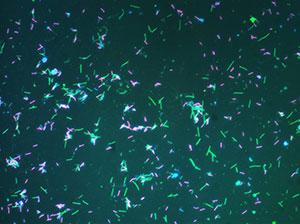First forms of life on Earth unveiled in hot spring
 (Download Image)
Steam rises from Great Boiling Spring, a nearly 200-degree natural pool where Lawrence Livermore scientists and colleagues from the University of Nevada, Las Vegas, California State University, San Bernardino and Stanford University have found the most ancient single-celled bacteria and archaea. Photo courtesy of UNLV.
(Download Image)
Steam rises from Great Boiling Spring, a nearly 200-degree natural pool where Lawrence Livermore scientists and colleagues from the University of Nevada, Las Vegas, California State University, San Bernardino and Stanford University have found the most ancient single-celled bacteria and archaea. Photo courtesy of UNLV.
Terrestrial geothermal systems are like buried treasure when it comes to finding out the origins of life on Earth.
In these underground hot springs, some of the most ancient single-celled bacteria and archaea live the life of extremophiles (organisms that live under extreme environmental conditions such as hot springs or ice caps). By their makeup alone, the microorganisms may reflect the nature of primitive environments, such as early Earth.
Lawrence Livermore National Laboratory (LLNL) scientists and colleagues from the University of Nevada, Las Vegas, California State University, San Bernardino and Stanford University, are working on a NASA project to study microorganisms in a Nevada hot spring that could determine whether extraterrestrial life exists.
This particular spring has lineages of life that have never been studied before. But with advanced technology, such as LLNL’s NanoSIMS -- which can determine the isotopic and elemental makeup of these organisms at the cellular and subcellular scale -- the team can dive into the organisms' catabolic and anabolic potential. The work also may provide insights into possible functions of early life in extreme environments and the early diversification of both single-celled and multicellular organisms.
The extremophiles’ characteristics may reflect the nature of primordial environments where life may have first formed on Earth. These bacteria and archaea found in Great Boiling Spring in Nevada are so primitive that they can’t be grown in a lab, so the team has had to study them where they are abundant.
"The organisms we’re looking at may be evolutionary relics of ancient lineages in which most members have become extinct and may be unique repositories for primitive traits," said LLNL principal investigator Jennifer Pett-Ridge. "What we know to date is that these extreme environments are very similar to what’s been found on other planets.
"These studies provide a lens though which we can view the phylogenetic and physiological diversity of life under ecologically simplified conditions bearing some similarity to habitats where life may have originated."
Since genomic explorations of yet-uncultivated microorganisms are providing insight into the early diversification of the tree of life and impacting models of the evolution of the first eukaryotic cells, understanding the biology of novel microorganisms is relevant to NASA's goal to understand "increasing complexity" during early evolution.
Though the origin of life is debated, there is considerable evidence for high-temperature aquatic environments following the Late Heavy Bombardment (an event that happened approximately 4.1 to 3.8 billion years ago in which a disproportionately substantial number of asteroids are theorized to have collided with the early terrestrial planets), when fossil and isotopic evidence suggest life first evolved. Recent reports suggest life originated in terrestrial geothermal systems based on the inorganic chemical composition of material inside living cells.
Specifically, the team will analyze the microorganisms named Calescamantes, Fervidibacteria and Kryptonia.
Other Livermore researchers include Rhona Stuart, Xavier Mayali and prior Lawrence Fellow Anne Dekas (now at Stanford University).
Contact
 Anne M. Stark
Anne M. Stark
[email protected]
(925) 422-9799
Related Links
NASA Astrobiology InstituteNASA Astrobiology Strategy
University of Nevada, Las Vegas
Tags
Physical and Life SciencesFeatured Articles








